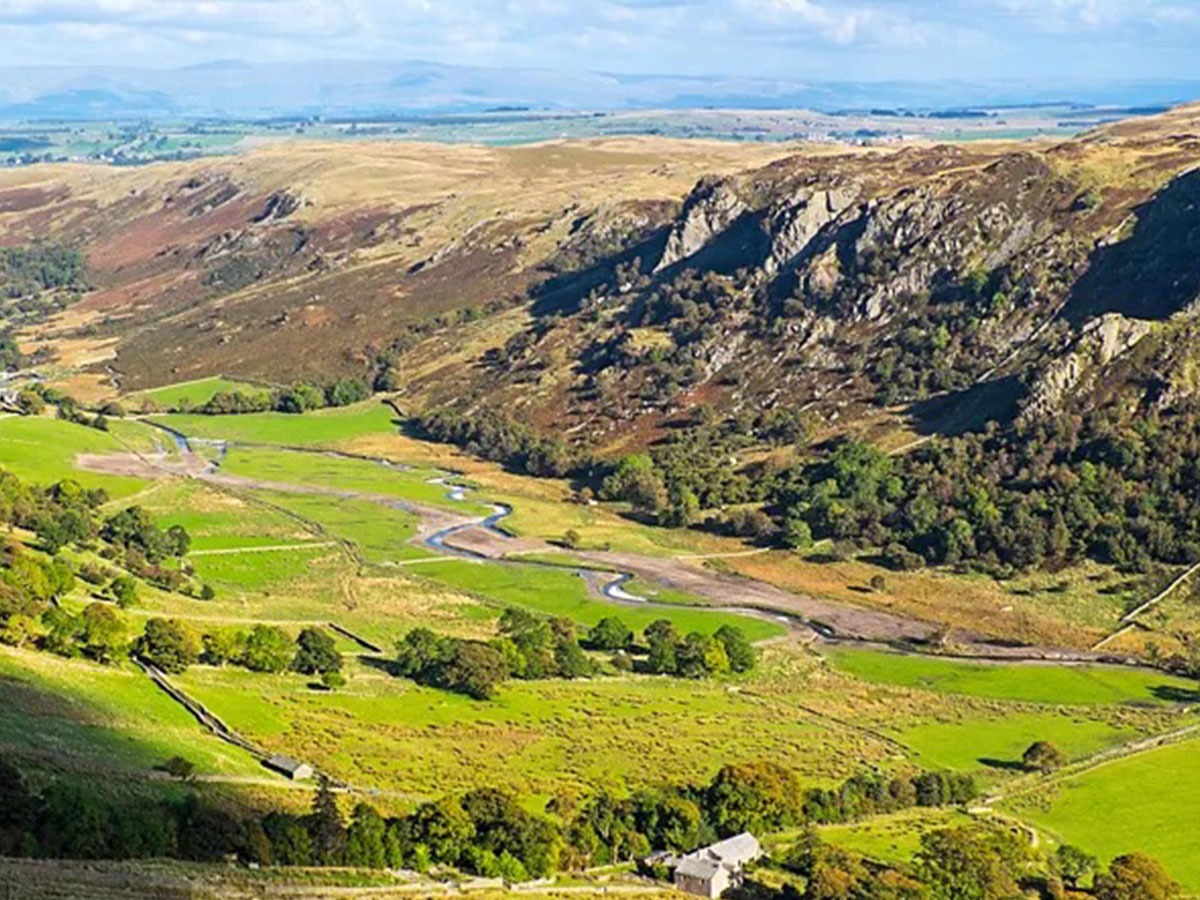
How Restoring River Meanders Can Reduce Flood Risks and Revitalize Ecosystems
For centuries, meandering rivers have been straightened, but experts now emphasize that restoring their natural bends and curves can help prevent flooding and create healthier habitats for wildlife.
Swindale Beck, a stream in Cumbria, located in the heart of the UK’s Lake District, winds through fields, farmland, and valleys. However, not too long ago, this river followed a far straighter path. A healthy river should be sinuous, free-flowing, and abundant with wildlife. Yet, 97% of rivers in Britain are fragmented by artificial barriers like weirs. Today, there’s at least one artificial barrier for every 1.5 km of stream in the country. For centuries, rivers have been gradually canalized—or artificially straightened—to prevent water from flooding farmlands and homes.
However, removing a river’s natural meanders has had the opposite effect. Instead of reducing flooding, this practice has disrupted natural water flow, degraded aquatic habitats, diminished water quality, and increased flood risks. As the declining health of Europe’s rivers and streams becomes more apparent—due to decreasing wildlife, sewage pollution, and agricultural runoff—communities are turning toward natural solutions to restore their rivers.
It took a team of diggers three months to put Swindale Beck’s curves back where they naturally belong. Some rivers are being restored using natural flood management (NFM) techniques, such as leaky woody dams, tree planting, and beaver dams. One idea that’s gaining traction is to reintroduce natural bends to rivers, streams, and tributaries. Around the world, from the Netherlands and the US to the UK, rivers are slowly being “re-wiggled” to restore their original courses. And in the UK, this approach is already yielding benefits, as fish, birds, and invertebrates return to rivers in Cumbria and West Sussex.

“You want riffles where the water flows over stones and gravels, creating bars and islands,” says Glen Swainson, the RSPB’s Site Manager at Wild Haweswater. Two hundred years ago, Swindale Beck was straightened to create more farmland. Since 2016, however, a project has been underway to reverse this process and restore the river to its natural state. Led by the Royal Society for the Protection of Birds (RSPB), the goal of this effort is to foster more diverse habitats, structures, and river morphology. According to Swainson, the ideal river is “very dynamic, messy, and chaotic,” with multiple channels that separate and rejoin across the floodplain.
After studying the valley to find the river’s original path, the RSPB enlisted a team of diggers to carve out new channels. The project, carried out in collaboration with the Environment Agency, Natural England, and United Utilities (the water company and landowner), cost more than £200,000 ($260,000) to restore a 1 km (0.6-mile) stretch of the river.
Birds like the dipper are now flocking back to these re-wiggled rivers. The first step of the project was to study the area and map the river’s historical path. Then, a team of diggers spent three months re-carving the meandering course as accurately as possible. Today, Swindale Beck is 180 meters (590 feet) longer than the straightened canal that had run through the valley for over two centuries.
According to Tom Hayek, a natural flood management specialist at the Wildfowl and Wetlands Trust (WWT), restoring meanders to rivers has two major effects: it alters both the speed and the volume of water flow. First, it reduces flow conveyance or the amount of water that can move downstream. “When the length of a river is increased, the water spreads over a wider area,” Hayek explains. “This allows more water to accumulate in the headwaters, where re-wiggling typically takes place, rather than downstream in towns.”
The second effect is on speed. Put simply, the more structure you add to a river’s morphology, the slower the water moves. If the river is straight, the water moves faster, says Hayek. “The increased speed and volume from tributaries can eventually overwhelm the river’s capacity, leading to flooding,” he adds. In the past, dredging rivers to increase capacity was common, but Hayek argues this doesn’t address the root problem. Instead, experts are turning to natural flood management techniques to restore rivers to their full floodplains.
Recently, catastrophic floods across Europe have put rivers in the spotlight. Devastating floods in Austria, Poland, the Czech Republic, and Romania have claimed more than 20 lives and forced thousands, including the entire town of Nysa in Poland, to evacuate. While river restoration can help mitigate smaller floods, experts warn it won’t be enough to prevent extreme floods like those seen recently, as the sheer volume of water is too great for absorption.
Scientists caution that climate change is contributing to increased rainfall and more frequent flooding in parts of Europe, as warmer air holds more moisture. Restoring rivers to their natural state, removing dams, and managing floodplains could help cope with higher flood risks, according to experts. Numerous restoration projects are underway or planned across Europe as part of this effort.
When a river’s flow is slowed, it creates deeper pools where fish can gather and rest. Areas where fine gravel accumulates are ideal spawning grounds for species like salmon, which previously bypassed these rivers. After Swindale Beck was re-wiggled, the results were “mind-blowing,” according to Annabel Rushton, visitor experience manager at Wild Haweswater. “A lot of nature conservation takes time—if you plant a tree, you won’t see it reach its full potential in your lifetime. But within three months of re-wiggling this one-kilometre stretch, salmon were spawning here for the first time in over 150 years.”
Although the salmon was the poster child of this restoration effort, increases in trout and minnows were also noted. There were additional benefits, too—water-loving vegetation returned, offering cover for young fish to feed and hide.
Re-wiggling rivers also allows them to naturally clean themselves. Straightened rivers flow faster, picking up more sediment along the way. In the past, murky water was often carried downstream to Haweswater Reservoir. Now, the river’s new curves encourage it to deposit sediment on the banks, improving water clarity and benefiting water companies.

Over 100 river restoration projects have taken place in Cumbria as part of this broader program. However, Swainson cautions that re-wiggling isn’t a one-size-fits-all solution. It’s challenging “to model the benefits of something that varies with every landscape, altitude, and substrate,” she explains.
Swindale Beck, for example, runs through a sparsely populated area with only a few homes in the floodplain. In more densely populated catchments with multiple landowners along the banks, restoration could be more complicated.
Nevertheless, the changing climate has intensified the need for river restoration. Wetter summers and increasingly severe rainfall events make natural flood management more urgent than ever. “Rather than experiencing many small, typical rainfall events, we’re now seeing intense downpours dropping ten times the amount of rain they used to,” Hayek explains.
As development continues, with more concrete surfaces, flood risks increase. Between straightened rivers, impervious surfaces, and climate change, we’ve created a “perfect storm,” says Hayek. This has fueled the push toward natural flood management techniques—methods that use natural processes to store and slow the movement of water through a river catchment. Leaky dams made from tree trunks or branches are one example of a natural obstruction that can hold back water on the banks, releasing it gradually over time. Other techniques include strips of vegetation, ponds, and beaver dams.
Where straightened rivers flow too fast, re-wiggled rivers slow the flow, allowing them to cleanse themselves and create healthier habitats for wildlife. At Knepp Castle Estate in West Sussex, similar restoration projects are underway. The estate, once used for intensive farming, was rewilded in 2001 and now serves as a model for river restoration methods.
The estate’s river, Adur, stretches for 32 km (20 miles), but the surrounding land was drained for farming in the 1800s, causing rivers to bypass floodplains. Since 2001, the estate has been working with the Adur & Ouse River Trust and the Environment Agency to restore the river’s meanders and improve water flow.
The project has also created new wetland habitats for insects, amphibians, and wading birds by restoring the channel to its natural state. Female bats have returned to the area, suggesting that the restored habitat provides an excellent feeding ground.

In addition to enhancing biodiversity, river restoration projects like these offer a natural solution to the increased flood risks posed by climate change. After a series of storms hit the UK in 2023, the WWT called on the government to increase spending on natural flood prevention by an additional £130 million ($169 million) per year.
“We should be re-wiggling and working with natural processes,” says Hayek. “We need to get these rivers back into their full floodplains.”





